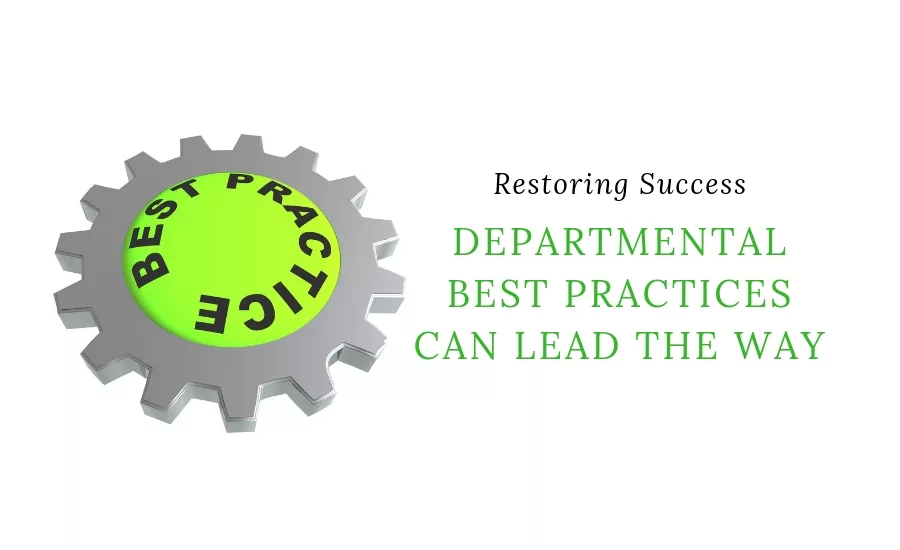Restoring Success: Departmental Best Practices Can Lead the Way

Definition of "Best Practice": a procedure that has been shown by research and experience to produce optimal results and that is established or proposed as a standard suitable for widespread adoption.
Best practice is a broad term that is used in many contexts and in many industries. It is often used to layout an exacting procedure in the execution of a task to produce an optimal outcome. Standard operating procedure (SOP) type of best practices are necessary and valuable within our operations for training, evaluating, quality control, and more.
Beyond the use of utilizing best practices for specific or detailed execution, they are great for departmental or managerial level execution. Departmental level best practices give a framework for success to managers without the need to micro manage competent and engaged team members.
All best practices have a couple things in common. First of all, they must be communicated and understood. At the most basic level, the Best Practice must be put into words and communicated as well as being accessible to those who are held accountable to them. Departmental best practices are meant to be hung on the wall as a constant reminder of what needs to happen to have the optimal result as defined by your organization.
The second important thing that best practices have in common is that to be effective, you have to train, equip, and engage those who are executing them. A good friend of mine who is also an experienced trainer, Mark Warner, CMI Education Manager, said it well when he explained to me how he teaches best practices, “I always talk about the worst practices when teaching best practices.” He went on to explain that he is able to get great buy-in about the best approach when he tells the stories of terrible outcomes from employing the worst practices.
Some of the benefits of employing departmental level best practices are:
- Expectations: It gives you a platform to document and clearly communicate the expectations of departmental level functions that will produce the best outcomes for your organization.
- Evaluations: Management level and or departmental level team members can easily be evaluated based on their adherence and contribution to the best practices during performance evaluations.
- Reduces tendency/need to micromanage: High level best practices will allow an organization to clearly communicate critical expectations in the execution of objectives without the need to micro or detail every movement.
- Organizational awareness: Individuals and other departments will know the expectations of others. This benefit will allow the operation to better and more efficiently serve customers. For example, if a production department (mitigation department, scheduling department, etc.) has a best practice to contact and schedule with the property owner within 24 hours of receipt of work order (scope, mechanism to trigger scheduling, etc.) In theory, others in the organization can communicate to the customer what to expect. Example: “Once we get an approval on the estimate, you will be contacted by the production department within 24 hours regarding the schedule.”
Tips to review or create Departmental Best Practices: Every organization is unique and there may be clear departmental delineation, for example: production department, project management, mitigation, contents, construction, marketing, estimating, accounting. Smaller organizations may have a handful of team members wearing multiple hats; however, you can still create departmental level best practices based on functional areas or the existing organizational structure. For smaller organizations it is just as important to have established best practices for management functions as they will be critical to growth, success, and adding new team members.
- Start with a best practice that refers back to abiding by your company’s values.
- Gather the key people: Bring your key people together, those responsible for the execution of the best practices and either review or create as a team. This is a great way to create buy-in and engagement while developing the formula for the best operational outcomes.
- Make a list of priorities for the department in broad terms. Examples:
- Communications
- Profitability
- Scheduling
- Quality
- Collection of Receivables
- Finalize: Once the priorities are established, create achievable and specific best practices. Broad examples:
- A minimum of one weekly documented contact with the property owner is maintained until job completion.
- An average of X % profit is achieved on jobs.
- Stay updated on new technologies and processes.
- Maintain and develop quality control processes.
Departmental best practices can lead the way to optimal outcomes in your service to others and help you grow and prosper as an organization. Hang them on the walls, talk about them, engage the team, and you will find restoring success.
Looking for a reprint of this article?
From high-res PDFs to custom plaques, order your copy today!









